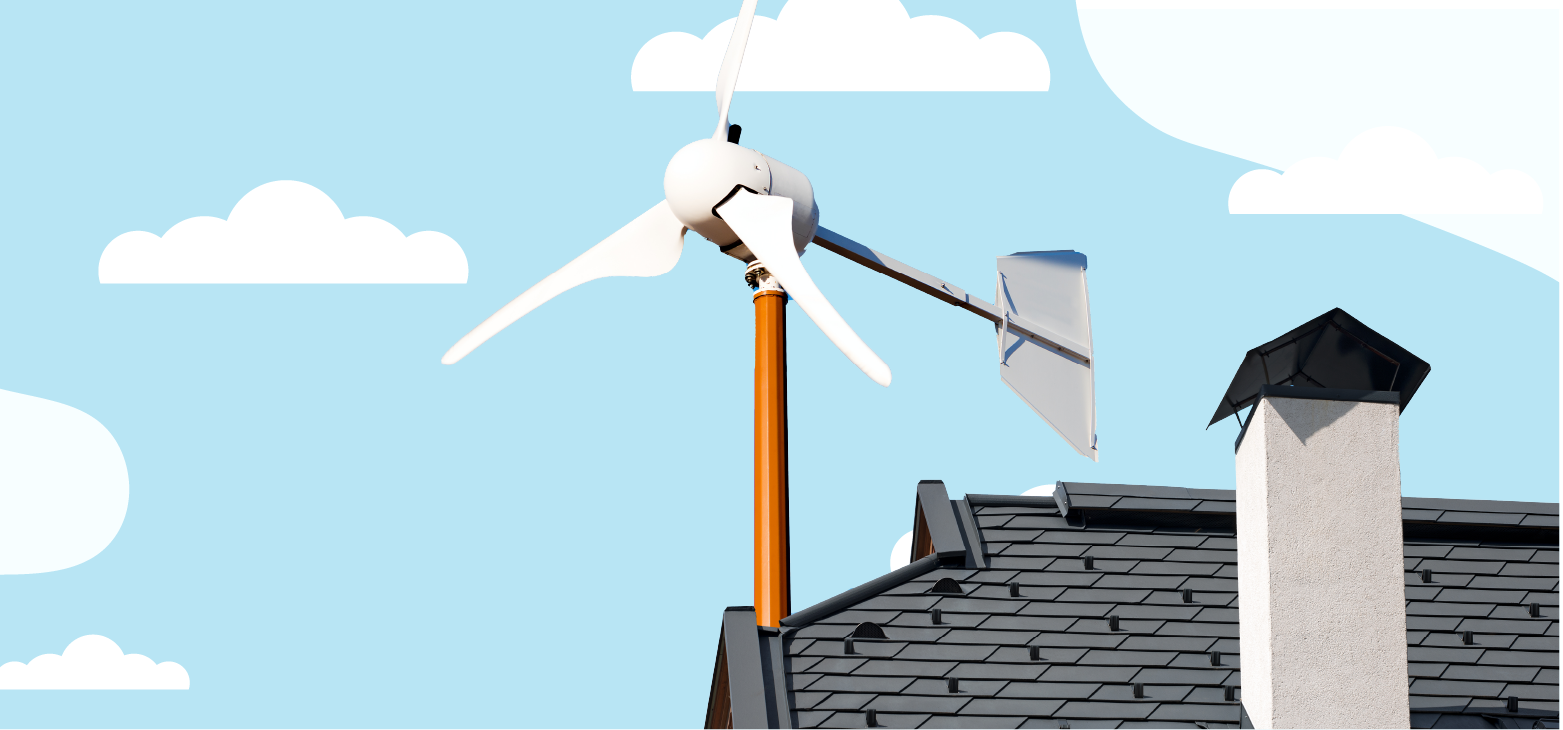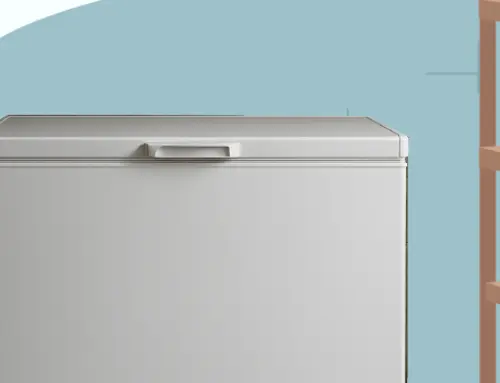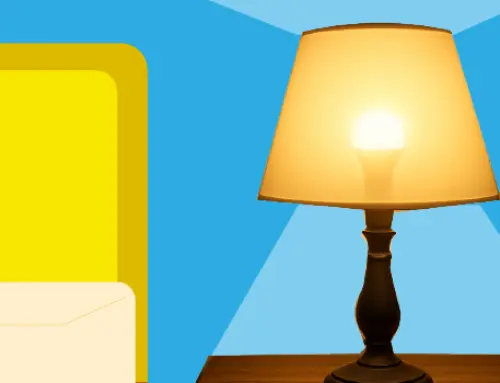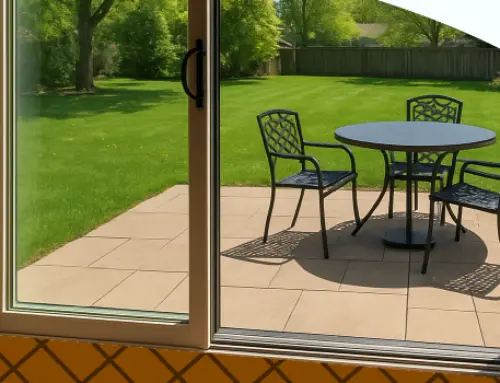How Much Does a Wind Turbine Cost?
by Tyler Castle
17.9 min read

As electricity prices rise and more homeowners seek sustainable energy solutions and residential wind turbines are gaining attention as an alternative to solar panels. But are they truly a smart investment for your home?
The answer isn’t one-size-fits-all. Installing a wind turbine depends on several key factors—your property’s wind speed, local zoning laws, upfront costs, and how much electricity you hope to offset. While a wind turbine can lower your electric bills and reduce your carbon footprint, it’s not suitable for every location or household.
In this guide, we’ll break down the costs, benefits, and challenges of residential wind turbines so you can decide whether wind power is worth it for your home. From the price of the turbine itself to installation, maintenance, and potential savings, you’ll get a clear picture of what to expect before making the leap into home wind energy.
How Do Wind Turbines Work?
A wind turbine works by turning wind into electricity for your home. When the wind blows, it moves the blades of the turbine, kind of like how a pinwheel spins in the breeze. These blades are connected to a part inside the turbine that turns the spinning motion into energy. Here's a closer look at how it happens:
1. The wind spins the blades
When the wind blows, it moves the large blades on the wind turbine. These blades are specially designed to catch the wind—similar to how airplane wings work—so they turn even with relatively low wind speeds. The amount of energy they generate depends on how fast and how consistently the wind is blowing. Once the blades catch the wind and start turning.
2. The spinning blades power a machine inside
As the blades spin, they rotate a central shaft connected to a generator inside the turbine's housing (called the nacelle). This generator uses magnetic fields to convert the mechanical energy from the spinning blades into electrical energy.
3. Electricity flows into your home or the grid
The electricity created by the generator flows through electrical cables. If you have a residential turbine, this energy can be used in your home right away to power lights, appliances, and electronics. If you're generating more electricity than you need, the excess can be stored in batteries for later use or sent back into the power grid, depending on your setup and local utility policies.
For a wind turbine to work well at home, you need to have steady winds in your area, usually at least 9 miles per hour. If your property is open, without tall buildings or trees blocking the wind, a wind turbine can be a great way to lower your electric bill and use clean energy.
Are Wind Energy Prices Decreasing?
As of 2025, wind energy costs are continuing to fall, and that's good news for everyone, including homeowners. According to BloombergNEF's 2025 report, the cost of wind power, along with solar and battery storage, is expected to decline by another 2–11% this year. This ongoing trend is largely fueled by China's dominance in clean energy manufacturing, which has created an oversupply of affordable equipment globally.
As a result, building new wind and solar farms is now cheaper than building new coal or gas plants in nearly every market around the world. And while some governments are introducing tariffs to slow down cheap imports and protect local industries, the long-term cost outlook still points downward with clean energy expected to drop another 22–49% in cost by 2035.
What Does This Mean for Homeowners?
With lower prices on wind energy, this leads to numerous benefits for homeowners interested in wind energy. Lower prices in wind energy can lead to lower electricity rates over time, especially in regions where utilities invest in cheaper renewable energy sources.
For those interested in residential wind turbines, there will be more affordable home wind systems, thanks to lower equipment prices. With lower prices in wind energy, this means that there's greater incentive to go green; meaning renewables are becoming more accessible and cost-effective than ever before.
In short, wind energy isn't getting "too cheap"—it's becoming more efficient, scalable, and homeowner-friendly, helping pave the way for cleaner, more stable energy bills and a more sustainable future.
Factors Affecting Wind Pricing
Of course, wind pricing can be very fickle, and there's a few external factors that affect the price of wind energy. Here are some of the most notable if you're interested in wind energy powering your home:
- Weaker wind = less energy: If wind speeds are low or inconsistent, turbines can't produce as much electricity as they might be able to, making each unit more expensive.
- Expensive equipment and setup: Building wind farms is a big job—turbines are huge and heavy, and getting them installed takes time, money, and special equipment.
- High maintenance needs: Wind turbines need regular checkups, part replacements, and trained technicians to keep them running.
- Far from where power is needed: The best wind is often in remote places. That means extra costs to build power lines and get the electricity to cities.
- Material and labor costs: If materials like steel or fiberglass go up in price—or if it's hard to find skilled workers—wind projects get more expensive.
- Permits and approvals take time: Wind farms must follow rules and go through environmental reviews, which can slow things down and add extra costs.
How Much Does a Wind Turbine Cost? (Residential)
The cost of your exact turbine will vary based on model, turbine, size, and cost of installation. However, the most standard home wind turbines cost around 20 to 80 thousand dollars with micro turbines costing the least with a minimum price of $500.
If you're looking to install a wind turbine on your residential property, here's how much it might cost you:
How Much Does a Residential Wind Turbine Cost?
| Turbine Size / Type | Average Installed Cost | Capacity / Power Rating |
| Micro Home Turbine | $500 – $4,000 | 0.4 – 3 kilowatts (kW) |
| Small Home Turbine | $3,000 – $15,000 | 3 – 5 kilowatts (kW) |
| Standard Home Turbine | $20,000 – $80,000 | 5 – 15 kilowatts (kW) |
Keep in mind that the cost of a residential wind turbine depends largely on how much energy you need and how strong the wind is in your area.
Micro turbines (0.4–3 kW) are designed to supplement your home’s electricity use, powering small devices or reducing your dependence on the grid. They’re budget-friendly and great for learning how wind power works on a smaller scale.
Small turbines (3–5 kW) can power parts of your home, such as lighting, electronics, or appliances, and may significantly lower your monthly electric bill.
Standard turbines (5–15 kW) are sized to power an entire household, especially in windy regions. Though they carry a higher upfront cost, they offer the most potential for energy savings over time.
How Much Does a Wind Turbine Cost? (Non-Residential)
| Turbine Size / Type | Average Installed Cost | Capacity / Power Rating |
| Horizontal-axis turbines | $3 and $4 million | Typically 1.5 MW to 3 MW each |
| Vertical-axis turbines | $3,000 and $8,000 per kW (Medium-scale) | Typically 10 kW to 100 kW (medium-scale) |
While industrial, or non-residential turbines are most ideal for large scale energy production, it's still noteworthy (and a fun fact) to know how much they cost! Large scale turbines, used to power cities can cost up to four-million dollars for a single turbine. Medium scale turbines are much cheaper and can cost less than $10,000.
Solar Panels or a Residential Turbine: What's Best for You?
When looking for renewable energy solutions to power their home, homeowners may be faced with choosing between solar panels or a residential wind turbine.
While they both produce clean energy, they vary with vast differences in cost, maintenance and installation. Here's how each breaks down:
Cost Differences Between Solar Panels and Residential Wind Turbines
| Type | Installation Costs | Maintenance | Energy Production | Long-term Investment Payoff |
| Solar Panels | $15,000-$25,000 for average system (5-10kW) | Low: annual cleaning and inspection; no moving parts | Consistent during daylight hours; varies with seasons and weather | 8-12 years typical payback; 25+ year lifespan |
| Residential Turbine | $20,000-$80,000 depending on size and tower height | Moderate to High: requires regular inspection of moving parts, occasional repairs | Varies day and night; dependent on consistent wind patterns | 10-20 years typical payback; 20-30 year lifespan |
Key Considerations When Choosing Between Wind and Solar
Still not sure which to choose? Here’s what to consider before you make your choice:
Both wind and solar solutions widely depend on your location and weather patterns. Solar works best in areas receiving 4+ hours of direct sunlight daily while wind works best in locations with average wind speeds of 10+ mph.
Space also plays a huge role in the efficiency of both energy solutions. Solar panels need unshaded roof space or ground area (approximately 100 sq ft per kW) while wind turbines require adequate space for tower installation (typically 1+ acre) and clearance from obstacles. Yeah, that’s a lot of space.
When it comes to installation, solar installation is relatively straightforward with minimal disruption, but wind installation involves tower construction, potentially requiring permits, engineering approvals, and heavy equipment. This can make for a long building and approval process if you’re looking to start harnessing your energy right away.
In short, wind energy works best if:
- You live in a rural residential area
- You get consistent wind speeds (10+ mph)
- You’re okay with mild noise from the turbine
- You have plenty of open land
- You live in a farming or agricultural community
And solar energy works best if:
- You live in a sunny region
- You have a roof with good sun exposure
- You qualify for tax credits or solar incentives
- You want a quiet, low-maintenance system
To learn more about the pros, costs, and ideal setups for each option, check out the full guide here!
How Much Energy Does a Wind Turbine Produce?
The energy output of a wind turbine varies depending on its size, location, and wind conditions. On average, a typical commercial wind turbine with a capacity of 2.5 to 3 megawatts (MW) can generate approximately 6 to 9 million kilowatt-hours (kWh) of electricity annually. This amount of energy is sufficient to power around 1,500 average U.S. households each year.
In the United States, wind turbines collectively produce about 434 billion kWh of electricity annually, making wind energy the third-largest source of electricity generation in the country.
To put this into perspective, the average American home consumes about 10,632 kWh of electricity per year, or approximately 29 kWh per day. Therefore, a single large wind turbine operating at optimal conditions can supply enough electricity to meet the daily needs of over 200 households.
A small residential wind turbine, typically rated at 10 kilowatts (kW), can produce around 10,000 kWh per year, which is enough to power a home depending on wind availability and system efficiency.
So while a commercial turbine powers neighborhoods, a residential turbine is best suited to helping individual homeowners cut electric bills and reduce reliance on the grid.
Does a Wind Turbine Pay for Itself?
Yes, a wind turbine can indeed pay for itself over time, but the duration of the payback period varies based on several factors, including the turbine’s size, location, installation costs, and available incentives.
The payback period refers to the time it takes for the savings generated by the wind turbine to equal the initial investment cost.
For homeowners investing in a residential wind turbine, the payback period typically ranges between 5 to 12 years. This estimate depends on factors like average wind speeds in the area, electricity rates, and the cost of the turbine and its installation.
Larger commercial turbines, such as a 2.6 MW model, have been estimated to recoup their initial costs in about 6 years and 7 months, considering average U.S. electricity prices and operational costs.
Several elements can affect how quickly a wind turbine pays for itself. Wind resource quality is one of the biggest factors that affect how fast you can pay off your wind turbine. Areas with strong winds enable turbines to generate more electricity, leading to faster cost recovery.
If you live in an area with high electricity prices, this can affect how fast you can pay off your turbine too. Higher local electricity prices mean greater savings when offsetting grid consumption, shortening the payback period. Lastly, government programs can significantly reduce initial expenses, accelerating the payback timeline.
Is a Residential Wind Turbine Right for You?
Installing a wind turbine for your home can be a smart move—but only in the right circumstances. Before making the investment, it’s important to understand what factors will affect the cost, performance, and long-term value of the system.
Key Factors to Consider if You’re Thinking About Purchasing a Residential Wind Turbine
- Location and Wind Resource: You need consistent wind speeds averaging at least 10-12 mph to make a wind turbine worthwhile. Rural, open areas with few obstacles tend to be best.
- Property Size: Most residential turbines require at least 1 acre of land, with enough space to install a tower 80-100 feet high, away from buildings and trees.
- Local Zoning and Regulations: Some areas have height restrictions, noise ordinances, or homeowner association rules that prohibit or limit wind turbines.
- Upfront Budget: With costs ranging from $3,000 for small systems to $80,000 for larger setups, you need sufficient capital to make the initial investment.
- Long-term Commitment: Wind turbines typically last 20-30 years but require regular maintenance—are you prepared for this ongoing responsibility?
- Grid Connection Options: Will you connect to the grid (with potential for net metering) or use batteries for off-grid power storage?
- Energy Goals: Are you looking to supplement your home’s power, achieve energy independence, or potentially sell electricity back to the grid?
If even a few of these factors seem unattainable to you, it might not be a good idea to invest in installing and operating a residential wind turbine.
Who Should Consider a Residential Wind Turbine?
Residential wind turbines aren’t for everyone. A residential wind turbine is ideal for homeowners who:
- Live in rural or coastal areas with consistent wind patterns and few obstacles
- Own at least 1 acre of land where a tower can be safely installed
- Currently pay high electricity rates (the higher your rates, the faster your payback period)
- Have a passion for renewable energy and want to reduce their carbon footprint
- Can afford the upfront investment or qualify for renewable energy incentives
- Plan to stay in their home long-term to recoup the installation costs
- Have mechanical aptitude or budget for professional maintenance
- Live in areas with net metering policies that allow selling excess power back to the grid
Who Should Look at Alternatives?
You might want to consider other renewable options and stay away from a residential wind turbine if you:
- Live in an urban or densely wooded area with poor wind resources
- Have limited property space that can’t accommodate a tower
- Face restrictive local regulations regarding height or noise
- Plan to move within the next 5-10 years (before reaching payback)
- Live in an area with abundant sunshine (solar might be more practical)
How Large of a Wind System Would I Need for My Home?
Wind turbines come in different sizes, typically ranging from 400 watts to 1,500 watts. The price depends on the size you choose, so it’s important to pick the one that best fits your energy needs to get the most value for your money.
To figure out which size is right for your home, think about how much energy you want to produce and the average wind speed in your area. The stronger the wind, the more power your turbine can generate. That means if you live in a windier location, you’ll be able to produce more electricity.
The size of the turbine you’ll need also depends on the size of your home and what appliances you use. In most cases, it is recommended to have the 1,500W model because it produces more electricity in less time—making it a great option for powering your home efficiently.
How Long Does a Wind Turbine Last?
Modern wind turbines are typically designed to operate for 20 to 30 years. However, this doesn’t mean all components last equally long. Wind turbine towers and elements are built to endure the full lifespan of the turbine, often requiring minimal maintenance. But parts like blades, gearboxes, and generators may need repairs or replacements within 10 to 20 years due to wear and tear.
Regular maintenance is essential to taking care of a residential wind turbine. Routine inspections and servicing, typically conducted every six months, help ensure optimal performance and longevity.
How Fast Do Wind Turbines Spin?
You might be surprised, but even though wind turbines look like they’re moving slowly when you see them from far away, their blades are actually moving really fast—especially at the tips.
Most wind turbines spin at about 10 to 20 rotations per minute (RPM). That might not sound very fast, but here’s the interesting part: the speed at the tip of the blade can be much faster than it looks. Smaller turbines might have blade tips moving at 75 to 100 miles per hour, while the bigger turbines can have blade tips speeding along at 150 miles per hour or more!
Why does this happen? Think of it like riding a merry-go-round. If you’re standing near the middle, you don’t feel like you’re moving very fast. But if you stand out by the edge, it feels much faster—even though the whole thing is spinning together. That’s because the outside has to travel a longer distance in the same amount of time to keep up. The same thing happens with wind turbine blades: the center moves slowly, but the tips have to move much faster to complete a full spin.
Engineers use something called “tip speed” to measure how fast the blade tips are going, while the number of rotations per minute tells how fast the whole rotor is spinning. Both measurements are important when designing a wind turbine to make sure it works safely and efficiently.
So next time you see a wind turbine, just remember—even though it looks slow from a distance, the ends of those blades are flying!
Residential Wind Energy Tax Credits
For those right for a residential wind turn, the U.S government offers special incentives to those looking to install a machine. The Residential Clean Energy Credit allows homeowners to claim a federal tax credit for 30% of the total cost of installing a qualified small wind turbine system. This includes both the equipment and installation expenses.
Here’s the specific credit amounts and timeline for this incentive:
- 30% Credit: Applies to systems installed between January 1, 2022, and December 31, 2032.
- 26% Credit: For systems installed in 2033.
- 22% Credit: For systems installed in 2034.
Keep in mind that no credit available for systems placed in service after December 31, 2034.
To qualify for the credit, the wind turbine must be installed at a home you own and use as your primary residence in the United States. Only new equipment qualifies for this incentive, and previously unused equipment also qualifies.
Your system must be installed and operational during the tax year for which you’re claiming the credit. If your property is used partly for business, the credit is available only for the portion of the cost allocable to residential use.
FAQ’s
How Long Are the Blades on the Wind Turbines?
Most turbines have three blades which are made mostly of fiberglass. Turbine blades vary in size, but a typical modern land-based wind turbine has blades of over 170 feet (52 meters). The largest turbine is GE’s Haliade-X offshore wind turbine, with blades 351 feet long (107 meters) – about the same length as a football field.
When wind flows across the blade, the air pressure on one side of the blade decreases. The difference in air pressure across the two sides of the blade creates both lift and drag. The force of the lift is stronger than the drag and this causes the rotor to spin.
Do Wind Turbines Use Oil?
Yes, wind turbines do use oil—but not to produce energy like a car engine. Instead, they use oil as a lubricant to keep important parts, like the gearbox and bearings, running smoothly and protected from wear.
A typical large wind turbine can hold hundreds of liters of oil in its gearbox. This oil needs to be checked and replaced regularly to prevent breakdowns and keep the turbine working efficiently.
So while wind turbines generate clean, renewable energy, they still rely on oil for maintenance and to keep their moving parts in good shape.
Wind energy offers exciting possibilities for clean, renewable power—but it’s not a one-size-fits-all solution. Whether a wind turbine is right for your home depends on factors like your location’s wind speeds, your energy needs, upfront costs, and available incentives. For some homeowners, especially in rural, windy areas, it can be a smart investment. For others, solar or other renewables might be a better fit.
If you’re looking for a more convenient way to help out the planet without setting up a residential wind turbine, consider Santanna’s Earth-Friendly Electricity plan! Through Earth-Friendly Electricity, you’ll be supporting more development, technology, and continued use of renewables. As a bonus, when you enroll in a Santanna Earth-Friendly electricity or natural gas plan, you can support reforestation efforts across the U.S as trees are planted for each enrollment!*
Learn more about Earth-Friendly Energy today!
* Santanna Energy Services (Santanna) works in partnership with One Tree Planted. For every residential Earth-Friendly Santanna gas or electricity initial enrollment or renewal, Santanna, via its One Tree Planted partnership, will plant trees after 60 days of billed usage. Plans may vary. See plan details for eligibility and current tree-planting promotions.
Tyler is an experienced energy professional, having worked for Santanna Energy Services, for the past four years. He is passionate about renewable energy and believes that diversifying the energy grid is the key to a sustainable future. Tyler is dedicated to supplying consumers with the best possible energy solutions and works diligently to make sure that Santanna can deliver the highest quality service.







